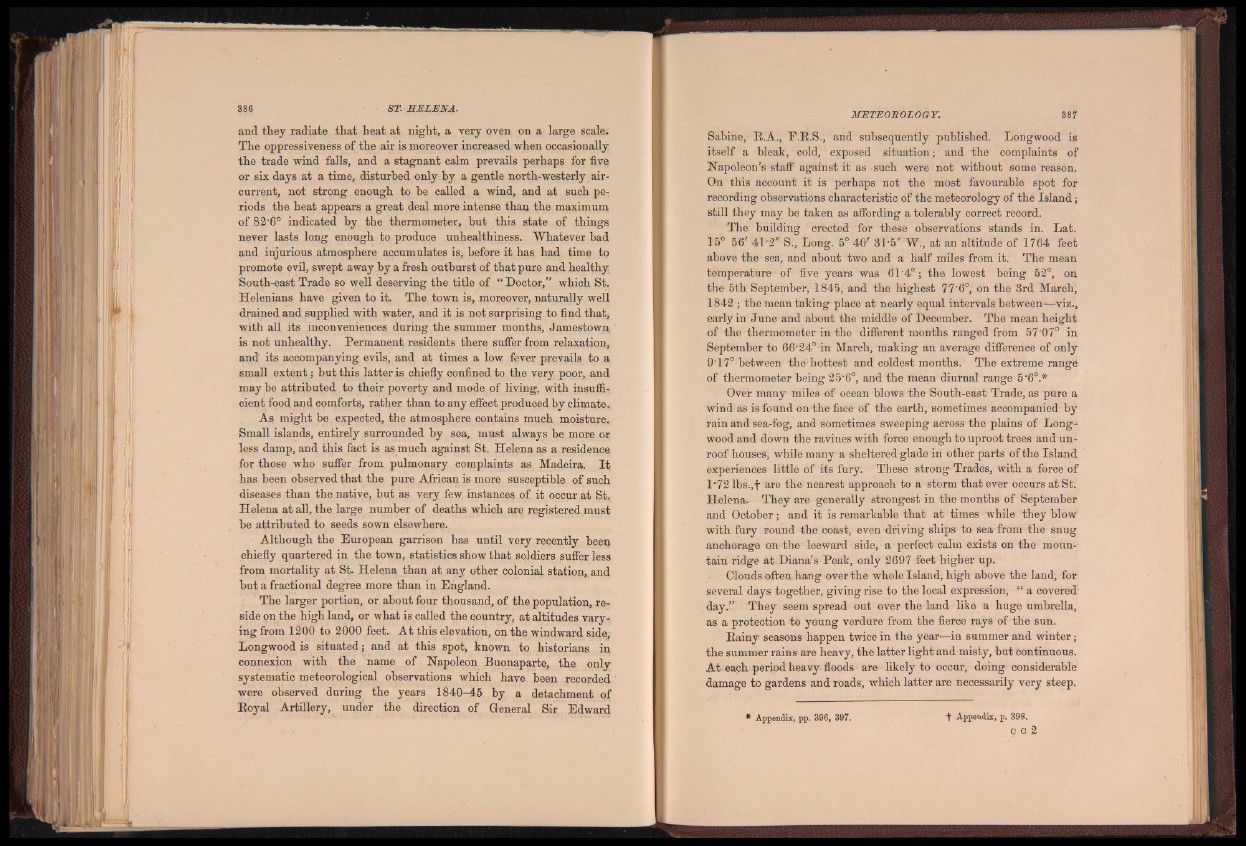
and they radiate that heat at night, a very oven on a large scale.
The oppressiveness of the air is moreover increased when occasionally
the trade wind falls, and a stagnant calm prevails perhaps for five
or six days at a time, disturbed only by a gentle north-westerly air-
current, not strong enough to be called a wind, and at such periods
the heat appears a great deal more intense than the maximum
of 82'6° indicated by the thermometer, but this state of things
never lasts long enough to produce unhealthiness. Whatever bad
and injurious atmosphere accumulates is, before it has had time to
promote evil, swept away by a fresh outburst of that pure and healthy
South-east Trade so well deserving the title of “ Doctor,” which St.
Helenians have given to it. The town is, moreover, naturally well
drained and supplied with water, and it is not surprising to find that,
with all its inconveniences during the summer months, Jamestown,
is not unhealthy. Permanent residents there suffer from relaxation,
and its accompanying evils, and at times a low fever prevails to a
small extent; but this latter is chiefly confined to the very poor, and
may be attributed to their poverty and mode of living, with insufficient
food and comforts, rather than to any effect produced bv climate.,
As might be expected, the atmosphere contains much moisture.
Small islands, entirely surrounded by sea, must always be more or
less damp, and this fact is as much against St. Helena as a residence
for those who suffer from pulmonary complaints as Madeira. I f
has been observed that the pure African is more susceptible of such
diseases than the native, but as very few instances of it occur a t St,
Helena at all, the large number of deaths which are registered must
be attributed to seeds sown elsewhere.
Although the European garrison has until very recently been
chiefly quartered in the town, statistics show that soldiers suffer less
from mortality at St. Helena than at an}1- other colonial station, and
but a fractional degree more than in England.
The larger portion, or about four thousand, of the population, re-,
side on the highland, or what is called the country, at altitudes varying
from 1200 to 2000 feet. At this elevation, on the windward side,
Longwood is situated; and at this spot, known to historians in
connexion with the name of Napoleon Buonaparte, the only
systematic meteorological observations which have been recorded
were observed during the years 1840-45 by a detachment of
Boyal Artillery, under the direction of General Sir Edward
Sabine, E.A., E.B.S., and subsequently published. Longwood is
itself a bleak, cold, exposed situation; and the complaints of
Napoleon’s staff against it as such were not without some reason.
On this account it is perhaps not the most favourable spot for
recording observations characteristic of the meteorology of the Island;
still they may be taken as affording a tolerably correct record.
The building erected for these observations stands in. Lat.
15° 56' 41'2" S., Long. 5° 40/ 31-5" W., at an altitude of 1764 feet
above the sea, and about two and a half miles from it. The mean
temperature- of five years was 61'4°; the lowest being 52°, on
the 5th September, 1845, and the highest 77'6°, on the 3rd March,
1842 ; the mean taking place at nearly equal intervals between—viz.,
early in June and about the middle of December. The mean height
of the thermometer in the different months ranged from 57‘07° in
September to 66'24° in March, making an average difference of only
9T7° between the* hottest and coldest months. The extreme range
of thermometer being 25'6°, and the mean diurnal range 5‘6°.*
Over many miles of ocean blows the South-east Trade, as pure a
wind as is found on the face of the earth, sometimes accompanied by
rain and sea-fog, and sometimes sweeping across the plains of Longwood
and down the ravines with force enough to uproot trees and unroof
houses, while many a sheltered glade in other parts of the Island
experiences little of its fury. These strong- Trades, with a force of
l -72 lbs.,f are the nearest approach to a storm that ever occurs at St.
Helena. They are generally strongest in the months of September
and October; and it is remarkable that at times while they blow
with fury round the coast, even driving ships to sea from the snug
anchorage on the leeward side, a perfect calm exists on the mountain
ridge at Diana’s Peak, only 2697 feet higher up.
Clouds often hang over the whole Island, high above the land, for
several days together, giving rise to the local expression, “ a covered
day.” They seem spread out over the land like a huge umbrella,
as a protection to young verdure from the fierce rays of the sun.
Rainy seasons happen twice in the year—in summer and winter;
the summer rains are heavy, the latter light and misty, but continuous.
At each period heavy floods are likely to occur, doing considerable
damage to gardens and roads, which latter are necessarily very steep.
* Appendix, pp. 396, 397. f Appendix, p. 398,
o c 2